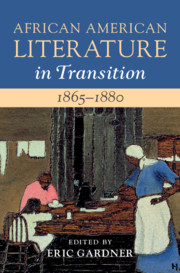Book contents
- African American Literature in Transition, 1865–1880
- African American Literature in Transition
- African American Literature in Transition, 1865–1880
- Copyright page
- Contents
- Figures
- Contributors
- Preface
- Chronology
- Black Reconstructions: Introduction
- Part I Citizenships, Textualities, and Domesticities
- Part II Persons and Bodies
- Chapter 5 Black Reform, Writing, and Resistance: Textual Politics in the Postwar Era
- Chapter 6 Post-Civil War Black Childhoods
- Chapter 7 Disabling Freedom: Bloody Shirt Rhetoric in Postbellum Slave Narratives
- Chapter 8 Radical Respectability and African American Women’s Reconstruction Fiction
- Part III Memories, Materialities, and Locations
- Index
Chapter 6 - Post-Civil War Black Childhoods
from Part II - Persons and Bodies
Published online by Cambridge University Press: 18 March 2021
- African American Literature in Transition, 1865–1880
- African American Literature in Transition
- African American Literature in Transition, 1865–1880
- Copyright page
- Contents
- Figures
- Contributors
- Preface
- Chronology
- Black Reconstructions: Introduction
- Part I Citizenships, Textualities, and Domesticities
- Part II Persons and Bodies
- Chapter 5 Black Reform, Writing, and Resistance: Textual Politics in the Postwar Era
- Chapter 6 Post-Civil War Black Childhoods
- Chapter 7 Disabling Freedom: Bloody Shirt Rhetoric in Postbellum Slave Narratives
- Chapter 8 Radical Respectability and African American Women’s Reconstruction Fiction
- Part III Memories, Materialities, and Locations
- Index
Summary
In “Post-Civil War Black Childhoods,” Nazera Sadiq Wright surveys some of the vast body of Black Reconstruction-era literature that features Black children as central characters, with special emphasis on Steward’s serialized Christian Recorder short story “The Gem of the Alley” and attention to work by Collins and Harper. Wright shows how repeated (and often accurate) representations of the little charitable institutions did to protect Black children contrasts with orphaned Black children’s dutiful and intentional displays of charity and good will toward those less fortunate. Wright asserts that, especially in frameworks centered on family reunification, Black child characters express the damage from class and racial divides as well as the healing grace of Black community activism in the post-Civil War era.
Keywords
- Type
- Chapter
- Information
- African American Literature in Transition, 1865–1880Black Reconstructions, pp. 138 - 160Publisher: Cambridge University PressPrint publication year: 2021

